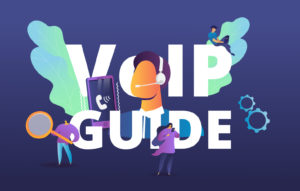Like most other businesses, that black block object sitting at your desk is usually used for answering calls and redirecting from one person to another, right? But is there any other way to use it? We wanted to integrate dynamic software into the traditional telephone to create a user-friendly system that completely disrupted the telecommunications market and how businesses used a telephone system. In many cases, the phone is the business’ primary weapon for battle. Those who know how to use it can transform a companies image and finances with each dialling of a number. Finding such transformative employees can be tough in a competitive market, that’s why, a robust phone system can improve the efficiency of all workers, maximising your companies output and aiding your workforce with the best opportunities to excel.
We had two core goals that would be delivered through byphone’s innovative VoIP technology:
- Improve Business Efficiency
- Improve Customer Experience
How did we go about this? To improve the complete UX for both admin and end-users, we first had to take a look at where businesses felt it was failing them.

Where Was It Going Wrong?
Simple Changes Were Complex
The reliance on engineers for simple system updates such as opening hours or voice messages made routine updates restrictive and costly. Businesses had little control over phone system functions and little insight into the processes behind updating them. Naturally, companies were at the mercy of the telecoms providers who could name their price for the slew of extra functions to the standard phone system, pricing out smaller companies who did not have the capital to invest in improving their communications to their desired level. With a holistic VoIP solution, many of the functions that were inflated previously are part of the standard package with byphone.
Call Data Was Difficult to Understand
We wanted businesses, large and small, to have the capability to capture call data and use the call patterns to improve how their business operated. We wanted to enable call record visualisation to allow for instant and accessible data insights for the non-expert in IT and telephony. Creating a system that was complex but simple to navigate was essential. Our mantra, ‘the power of simple’, truly reflects the system we have created for all users to view mass amounts of data in a simplistic form.
Poor User Experience
The desk phone; a pretty unremarkable object which leaves you glued to your desk, right? We wanted to change this. Our ambition was to create a more personalised and mobile system that allowed for greater flexibility in out of office working, with more efficient call management. Creating a platform that linked multiple devices, both mobile and landline, gave users the option to be available anywhere, as long as they had an adequate internet connection. Our interface allows you to link the number attached with your device at ease, taking away the stress of being unreachable under your work line when out of office.
Lack of connection
A poor broadband connection can have huge implications when running a cloud-based phone system. We wanted to provide users with real-time, easy to understand statistics on how their network is performing to ensure excellent call quality. Sometimes, people look at the online tools and systems they’re seeking when poor performance ensues. Instead, problems can originate from the broadband provider. Alongside our VoIP platform, our byroute software solely focuses on separating the network to alienate voice to its unique circuit. Thus, your network is never throttled to its capacity, avoiding the likelihood of losing data packets and affecting the delivery of voice on a call.
How We Built a Better Telephone System
A standard user issue was just how complex the call systems were – we needed to find a way to simplify them. Our main goal was to allow both IT expert and tech novice to understand and integrate the core features of the system without digesting the user manual. We approached the design with the following criteria:
Visualisation
When a call rang through, we wanted to visualise and map the route through the phone system, to better understand how the call was being managed and how it could be managed better. To achieve this we used organisational charts, which mapped a call journey through a hierarchical diagram from ringing to the required destination.
When you make a call, that call is filtered to a specific ring group set up in the architecture of your business’ call flow. We gave each of these call groups identifying properties, such as failure to travel to the next ring group or going to a voicemail. We also created templates to apply to these call flows. However, things got a bit trickier when we encountered more complex systems with multiple numbers.
Complex Call Routing
The more sophisticated phone system functions were controlled by ring groups while to edit a call flow; you had to edit the ring group. Thus, this created the obvious problem of routing calls to non-ring groups, such as announcements, time conditions and group voicemails.
For a customer that has 600 numbers, it may have required programming 600 organisational charts; this was too resource-intensive and caused mass amounts of duplication. But how else could we attach a new announcement to a number? The core problem was that each operation in a system needed to be independent of each other opposed to attached to a ring group. We needed to be able to route ten numbers into a single announcement.
We turned to graph theory; a branch of mathematics that is used in networks, based on Euler’s famous seven bridges of Koinsberg. By substituting nodes (landmasses in Eulers original work) and links (bridges) with functions on a phone system (nodes) and connections between these functions (bridges) we were able to adapt drag and drop technologies to control a phone system. Users are now able to create complex systems with multiple numbers directing to specific ring groups quickly and easily.

How Have We Improved User Experience
Byphone was built around three groups of individuals in mind: the admins, managers and users. We wanted to provide a revolutionary user experience to these business telephone users, allowing them to visualise both how their calls are routed and the call patterns they were receiving. byphone’s system enables changes to be made easily, providing a visual way to understand data, which gives end-users full control over their phone system from anywhere in the world. All in a few clicks.
We provide excellent user experience by empowering all levels of staff to carry out their job more easily, and more efficiently – which improves your performance as a business. Byphone provides users with easy to navigate software; linking their telephones while visualising key insights to help them improve their business. Once they have these insights, users can execute changes easily by using the user-friendly drag and drop technology.



